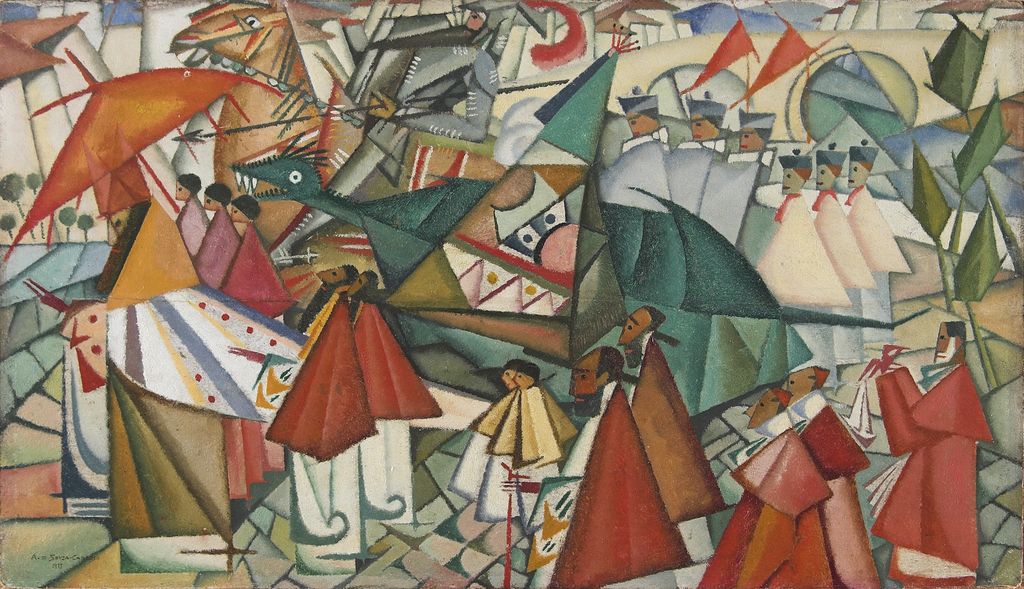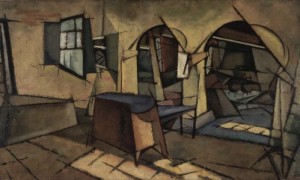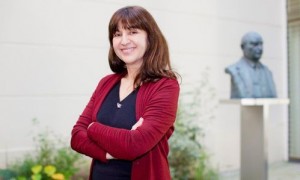The best kept secret in modern art

Almost one century on from the disappearance of Amadeo de Souza-Cardoso (1887-1918), the Grand Palais in Paris is dedicating a major exhibition to the artist, from 20th April to 18th July, that brings together around two hundred of his works along with others by his close circle such as Brancusi, Modigliani, Robert and Sonia Delaunay.
Throughout all of the 20th century, there can be no more surprising example of a major artist having fallen into obscurity than that of Amadeo de Souza-Cardoso. A leading figure in the modernist Parisian vanguard, he left behind a dazzling body of work that reflected all of the aesthetic revolutions ongoing in his time whilst simultaneously proving absolutely unique and original. His premature death at the age of 30, right at the end of World War I, deprived him of artistic consecration and his place in the international history of art.
The selection, displayed in one of the most emblematic and best visited venues in the Parisian capital, constitutes a fine opportunity to internationally reveal “one of the best kept secrets in modern art”, to quote the North American art historian Robert Loescher.
The curator is Helena de Freitas, one of the leading specialists in the work of Amadeo, coordinator of the catalogue raisonné of the artist published by the Gulbenkian Foundation and responsible for the exhibition Dialogue of the Vanguards that the same Foundation hosted in 2006 and that became the most visited art exhibition in the history of this institution.
Paris and Manhufe
The life of Souza-Cardoso was short and intense, highlighting two decisive periods featuring in this exhibition: his life in Paris (1906-1914) and his return to his land of birth, Manhufe (1914-1918). During this period spanning a little over a decade, the artist lived between these two worlds, between constantly toing and froing, permanently dissatisfied and wishing to be wherever he was not in a state of constant geographic instability.
A son of a traditional rural bourgeois family, Amadeo departed for the French capital in a financially comfortable situations to the contrary of many of his compatriots from whom he would rapidly distance himself. In Paris, a euphoric centre of all ruptures, his curiosity guided him towards those artists that were breaking with all the canons of classical representation. Amadeo proved another author of these ruptures and entered into the international circuit developing a creative dialogue with his working companions: Modigliani, Brancusi, Archipenko, the Delaunays, Otto Freundlich, Boccioni, among others, whilst establishing networks with artistic agents, publishers and curators such as Walter Pach, Wilhelm Niemeyer, Ludwig Neitzel, Herwald Walden, Adolphe Basler or Harriet Bryant (owner of the Carroll Galleries in New York).
His integration into the artistic dynamic of the international vanguard also reflects in the rise in profile of the exhibitions that he staged over the course of this brief period. He participated in key French salons that proved defining for the new artistic propositions, such as the Salon des indépendants (1911, 1912) and the X Salon d’Automne (1912), which took place precisely at the Grand Palais, where he exhibited the work Avant la Corrida, a canvas that would also go on display in New York at the renowned Armory Show exhibition in 1913. This work caused an enormous sensation alongside the paintings presented there (Amadeo sold seven of the eight works on exhibition, three of which are now found in the Art Institute of Chicago).
One artist, one plural identity
The place of departure (the small village of Manhufe, in North Portugal) constitutes the first stamp of identity of this artist and persists as the matrix running throughout the multiple stages of his work. However, “place” is not here about only a landscape or the representation of nature; rather this encapsulates something that Amadeo considered simultaneously to be his belonging: the natural but also the cultural landscape. And it was the latter dimension that wielded a transformative action over what might have been a set of conservative and immutable landmarks: mountains and objects of daily life, popular song lyrics and dolls, regional musical instruments, vines, imagined castles and family domestic interiors, woods and local human typologies.
These varied elements undergo representation according to stylistic solutions characterised by the cubist, futurist, orphic and expressionist hybridism that runs throughout his work. Amadeo incorporates the elements of a rural and familiar landscape along with the characteristic features of the modern world in the same dynamic and without any explicit hierarchy to attain a moment in which he interweaves his place of origin with the vertigo of the machines, mechanical figures, telegraph and phone lines, electric bulbs and advertising posters, the radio broadcasts, perfumes, champagne…
Urban by the determination of his will, the artist remained bonded to the waving movements of his mountains that he repeatedly painted and that served as the “background” to works from many of his phases. And it is on these mountains that he sets out his own self-representation, dressed as a painter in the style of El Greco.
The space of representation does not seem sufficient for everything the artist wishes to place within, integrating (also as a collage) many objects, local or urban, into a singular combinatory play. The importance attributed to words and the incorporation of letters into his works displays his encounter with contemporary new artistic practices. The letters/words, applied in cardboard or zinc stencils (commissioned or made by him), introduce more polysemic elements into painting and thereby facilitating references to industrial (“Barrett”, “Wotan”) and commercial (“Coty”, “Brut”, “300”, “Eclypse”) publicity but leaving them without any clear narrative or illustrative role in the painting.
Amadeo deviates from original meanings just as he does with shapes: his chromatic disks, might be coloured targets, whether from the fairground or the battleground; or they might be popular porcelain saucers into which insects fall.
This succession of indications of his incorporating the new world serves to reinforce the conviction that Amadeo had an active awareness of what it meant to be “modern”, not only in the themes (the exaltation of the mechanisation of the natural and the human), but also the methods and techniques applied to deal with them and still furthermore in the will to achieve a greater profile through fostering a personal image (such as recourse to the publication promoting XX Dessins or the 12 Reproductions or the stamp made by his own signature).
His premature death, at the age of 30, victim of the Spanish flu epidemic, contributed towards his progressive entry into obscurity at the international level that this exhibition, one century later, seeks to reverse.
In an autonomous room, but visually interacting with the remaining rooms, the exhibition features the presentation of a work commissioned from the artist Nuno Cera, Tour d’Horizon, a video installation, an original HD creation with 3 synchronised channels based on the landscape/place of work and the universe of creation of Amadeo de Souza-Cardoso.
AMADEO DE SOUZA-CARDOSO (1887-1918)
Curator: Helena de Freitas
20 April – 18 July 2016
Grand Palais, Paris
Interview with the exhibition curator Helena de Freitas
A decisive step towards the international valuation of Amadeo
How did the proposal to present in the Grand Palais come about for an artist with the scant international visibility of Amadeo?
This was a longstanding ambition that, after countless contacts undertaken by the Gulbenkian Foundation, encountered the ideal context in the commemorations of the fiftieth anniversary of the presence of the Calouste Gulbenkian Foundation in France. The project derived from a base of published research work that facilitated the presentation of the artist. Without the groundwork previously completed within the context of publishing the catalogue raisonné and the Dialogue of the Vanguards exhibition and all the associated publications, this exhibition would have been more difficult. One of the most extraordinary moments in this process was my first meeting with Laurent Salomé, director of the Grand Palais, who received me with a question. On slowly turning the pages of the catalogue, he asked me: but, after all, just who was this artist and how was it possible that I do not know of him? This exhibition also owes much to his intelligent, sensitive and courageous vision.
Would you highlight some special moment in the process leading up to this exhibition?
That was undoubtedly the night of the attacks in Paris and the direct observation of the capacity for resistance and struggle of the French. This had a decisive impact on the development of my work and the capacity to overcome difficulties.
How does a specialist in the work of Amadeo perceive this opportunity?
Staging this exhibition in the Grand Palais, a venue destined to the presentation of consecrated artists, in the same rooms that recently exhibited works by Velázquez and Picasso, guarantees the international visibility of a body of work that remained invisible throughout many decades and certainly contributing towards projecting him towards a broader public, which will also include specialists on the artistic context of the early 20th century vanguards. This is without doubt an opportunity that deserves all of our greatest attentions and also coming at the right moment: within the context of an ongoing historiographic revision based upon the concept of plural modernity. As highlighted by Catherine Grenier, historian of art and author of one of the essays published in the catalogue to this exhibition, Amadeo de Souza-Cardoso and Fernando Pessoa personify this new perspective on modernity, heterodox, multiple and without hierarchies.
This is an opportunity to replicate, one century on, all of the renown that the artist experienced while alive and to exhibit the diversity of his work across its multiple phases. In this context, a particular highlight of this exhibition is the final phase of his production, in Manhufe, and that corresponds to a dazzling period of experimentation and synthesis in a period otherwise totally unknown to his international peers.
Amadeo had already exhibited in this room…
In fact, this does represent a return and the site of this return proves symbolic. Amadeo had exhibited in the Grand Palais in 1912, within the context of the X Autumn Salon, when he presented Avant la corrida, today in the Calouste Gulbenkian Museum collection. This was the last exhibition he held in Paris during his life as in the following year he decided to invest in other territories, diversifying his notable exhibition range: he participated in the Armory Show that toured New York, Chicago and Boston, and at the first German Autumn Salon, organised by the Der Sturm gallery in Berlin. Furthermore, in this same year, he contributed towards the important collective exhibition in Vienna, at the Galeria Miethke, alongside artists such as Kokoshka, Kisling, Picasso, Léger, Braque, Manet, Renoir, Cézanne, Van Gogh and Pissaro, among others. The preface and the catalogue of this exhibition were written by Adolphe Basler, the renowned art critic and French art dealer of Polish origins. In 1914, he also took the opportunity to exhibit his works in London, in the London Salon, and in Hamburg.
This Grand Palais exhibition also emerges as the closing of a cycle and even of a more recent history as this follows on from the exhibitions held in Washington (At the Edge, 1999), Lisbon (Dialogue of the Vanguards, 2006) and Hamburg (Ein Pionier aus Portugal, 2007). However, this should also constitute the point of departure to finally get to know this Portuguese artist in the city where he chose to live and work.
Since the Dialogue of the Vanguards exhibition through to today, have any new factors emerged to contribute new clues to the works of Amadeo?
This exhibition provides continuity to the research work that the Gulbenkian Foundation and other research centres have been engaged in. This does also provide the opportunity to make public new interpretative clues, important discoveries and, through them, bring the public closer to the thinking and working processes of this artist.
I would highlight the matrixes for the reproduction of the designs for XX Dessins, the stencils in zinc for the introduction of letters and graphical signs to his paintings but also as well as unpublished documents and photographs found in his archives and of extraordinary importance in relation to his work. I would equally highlight the recent location of a work that may possibly be among the last produced by the artist. This is a signed work, composed of paper collages based upon which we may deduce the scope for a new approach that would deepen his working method and a theme, already present in his earlier works, which clarifies the relationship between art/publicity.
Is it possible to recover an artist from obscurity?
Through exhibition and continual promotion and a strategy for their coherent and effective internationalisation. This exhibition (as with the various others) has already guaranteed the study of the work of Amadeo by the art historians contributing essays to the catalogue: Catherine Grenier, Javier Arnaldo, Christian Briend and Jean-Claude Marcadé. The catalogue also includes a text by Maria Filomena Molder that introduces readers to the artistic and literary universe of Amadeo. However, as I referred to, this exhibition also represents a point of departure and certainly a powerful stimulus as was already the case with the Dialogue of the Vanguards exhibition towards the development of new paths for research and interpretation.
At this moment, we seek to valorise something that the historiography of art has neglected, the heterogeneity and simultaneity of the artistic experiences of Amadeo and his distancing from groups or “schools”.
Is Amadeo finally going to take up his rightful place in the history of European modernism?
Fostering the historical revision of the work of Amadeo de Souza-Cardoso and updating his interpretations, this exhibition does constitute an important and decisive step towards the international visibility of the artist. However, I would again state that only a continued strategy, across various fronts and experienced in museums and universities, may ensure his place in history.
The work of Amadeo opens up a clarified and distanced vision of the different movements making up the Parisian vanguard, which enriches the international study of this period, questioning the hegemony of the major centres over the cultural peripheries, a debate that is very much ongoing. Another important aspect is the dialogue provided with his sources and the artistic and literary references of his time, presenting a selection of the works by those contemporaries he was particularly close to, both in personal and in artistic terms, such as Modigliani, Brancusi and Robert and Sonia Delaunay.


